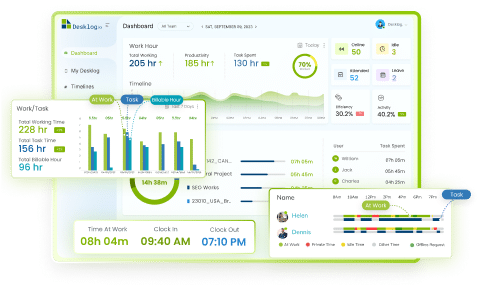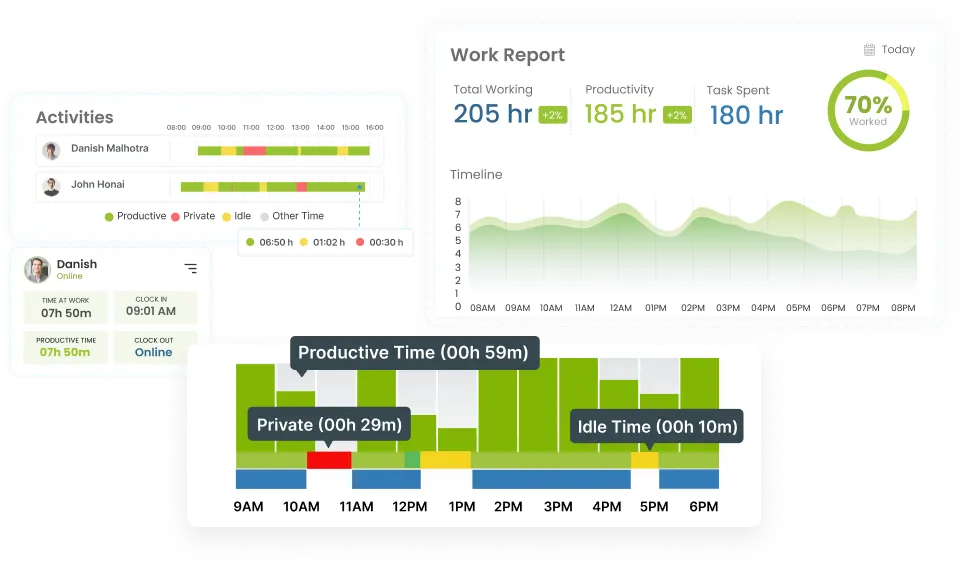
How to Measure and Improve Employee Satisfaction

“Satisfied employees mean satisfied customers, which leads to profitability”
Anne M. Mulcahy
In any thriving organization, the heartbeat of success resonates within the satisfaction and contentment of its workforce. Employee satisfaction stands as a cornerstone, a pivotal factor that significantly influences the overall health and prosperity of an organization.
Understanding and measuring employee satisfaction is a multifaceted endeavor that delves deep into the psyche of an organization’s most valuable asset – its people. In this blog, we delve into the intricate realm of how to measure employee satisfaction. And ofcourse, how to improve it.
Join us on this journey as we uncover the critical elements that elevate employee satisfaction, ultimately fostering an environment where individuals feel valued, engaged, and poised for collective success.
What is Employee Satisfaction?
Employee satisfaction serves as a measure utilized by employers and managers to determine the happiness of their team members with their roles and the company. It’s about whether they feel good about their work, their coworkers, and their company. It encompasses a spectrum of factors: the work environment, company culture, compensation, benefits, work-life balance, opportunities for growth and development.
Higher levels of employee satisfaction often correlate with increased positivity and productivity among team members. Conversely, when employee satisfaction is low, it can lead to a significant retention of employees from the company. And that is why numerous organizations opt for routine surveys to measure employee satisfaction levels and future trends over time.
The Correlation Between Employee Satisfaction and Engagement

Employee engagement is the emotional commitment employees have towards their organization’s goals and values. Engaged employees are passionate advocates for their company, willing to go the extra mile to achieve common objectives
The relationship between these two is symbiotic. Picture satisfaction as the foundation upon which engagement thrives. When employees are satisfied with their workplace, it lays the groundwork for engagement to flourish. Conversely, engaged employees fuel higher levels of satisfaction by being more involved and invested in their roles.
The Importance of Measuring Employee Satisfaction
Measuring employee satisfaction is integral to fostering a thriving workplace environment. It serves as a barometer of an organization’s overall health and boosts productivity in the workplace.Several critical factors underline the importance of consistently gauging and improving employee satisfaction.

Employee Retention
High employee satisfaction is often linked with increased retention rates. Satisfied employees are more likely to stay with an organization, reducing turnover rates. This stability contributes to a more experienced workforce, saving costs associated with recruitment, onboarding, and training new hires.

Productivity and Performance
Contented employees tend to be more engaged and motivated in their roles. When employees feel satisfied with their work environment, they are inclined to invest more effort and enthusiasm into their tasks. This heightened engagement will have higher employee performance enhancement leading to higher quality output and enhanced efficiency.

Company Culture and Morale
Employee satisfaction plays a pivotal role in shaping an organization’s culture. A positive work atmosphere, where employees feel valued and appreciated, fosters a sense of belonging and encourages teamwork. Satisfied employees are more likely to be ambassadors for the company, promoting its values and contributing to a positive workplace culture.

Innovation and Creativity
Content and happy employees are more inclined to think creatively and contribute innovative ideas. When satisfaction levels are high, employees feel more comfortable expressing their thoughts and experimenting with new approaches, which can significantly benefit an organization’s growth and development.

Customer Satisfaction
Happy employees often lead to happy customers. Satisfied employees are more likely to provide superior customer service, as they are motivated to go the extra mile in delivering exceptional experiences. Their positive attitude and commitment to their roles positively impact customer satisfaction and loyalty.

Identification of Issues and Improvement Opportunities
Regularly measuring employee satisfaction allows organizations to identify potential issues and areas for improvement. By collecting feedback through surveys or other means, employers gain valuable insights into the specific aspects of the workplace that require attention.
7 Methods of Measuring Employee Satisfaction
1.Send Out Surveys
Sending out employee satisfaction surveys are a great way to measure employee satisfaction. They can gain feedback on a variety of topics, including their satisfaction with their job, their manager, the company culture, and their work-life balance.
Surveys can be administered online, on paper, or in person. But in this digital age, we never go for those old traditional methods. As we have many softwares to get these surveys done. Well, we’ll come to that later.
As of now, we can concentrate on how these surveys help get things done? Employee satisfaction surveys can help organizations to:



Consider doing a monthly survey centered on specific topics like communication, teamwork, or growth opportunities. Now what questions do you want to ask the employees? In my opinion, I suggest you ask both open minded and multiple choice questions. You could ask them more questions that require them to rate on a scale.
Here are a few questions to consider asking in your survey:






2. Have 1-on-1 meetings with Your Team
While anonymous surveys serve as a great means to gather candid feedback, engaging in one-on-one conversations with your team members holds vital significance in establishing connections with your employees. In these meetings, managers can ask employees about their job satisfaction, their work-life balance, and any concerns they may have.
These meetings provide an opportunity for open communication, where employees can discuss their concerns, career aspirations, challenges, and feedback in a more personalized setting. Through these conversations, managers gain deeper insights into the factors influencing individual satisfaction, allowing for targeted support, recognition, and interventions as needed to improve employee morale and satisfaction.
Remember the following points while conducting 1:1 meetings




3. Observe the Workplace
Another method to measure employee satisfaction is to observe the workplace. When questioning if your team is happy, quietly observe how they act at work. If you notice your team members are always smiling and laughing with one another, this could be a good sign of satisfied employees. If you notice everyone seems tired and stressed, you may need to help people find a better balance at work. You can tell quite a lot by people’s levels of productivity and nonverbal cues such as body language.
Observing the workplace environment can be an effective method to measure employee satisfaction. Here’s how :
1. Employee Behavior and Interaction
Content and engaged employees tend to communicate positively, collaborate effectively, and display enthusiasm in their work. Conversely, dissatisfied employees exhibit disinterest, lack of engagement, or conflicts among colleagues.
2. Workplace Atmosphere
Observing the ambiance, such as whether it’s lively, supportive, or tense, can provide insights. For instance, a positive atmosphere with elements like natural light, comfortable seating, and organized spaces tends to create higher satisfaction levels.
3. Body Language & Facial Expressions
Non-verbal cues like body language and facial expressions can provide subtle clues about employees’ satisfaction levels. Observing if employees seem relaxed or stressed can give you insights into their overall satisfaction at work.
4. Employee Interaction with Management
Satisfied employees often have healthy, respectful, and constructive relationships with their superiors. Conversely, a lack of communication or strained interactions might indicate underlying dissatisfaction.
4. Use the Employee Satisfaction Index (ESI)
The employee satisfaction index (ESI) is a measure of employee satisfaction that is based on a set of standardized questions. The ESI is a good way to compare employee satisfaction across different departments, locations, or demographics. You can send your ESI questions separately or you can add them to an already-existing survey.
The ESI can help organizations to:



You can calculate ESI with the formula,
ESI = (question mean value/3) x 100.
The result will be a number between 1 and 100, where a higher score indicates greater employee satisfaction. Although the score alone cannot explain the facts, it can be combined with a thorough survey to yield more insightful results.
5. Use the Employee Net Promoter Score (eNPS)
The Employee Net Promoter Score (eNPS) is a measure of employee loyalty that is based on the question: “On a scale of 0 to 10, how likely are you to recommend this company to someone as a place to work?” The eNPS is a good way to measure how likely employees are to stay with the organization and to recommend it to others.
Based on the results, you can sort employees as following:
Promoters (Score – 9 or 10)
Promoters are considered enthusiastic and loyal advocates of the company. They are the highly satisfied and engaged employees who speak positively about the organization, both internally and externally.
Passives (Score – 7 or 8)
Passives are generally satisfied with their work environment but might not be as enthusiastic or vocal about recommending the company compared to promoters. They are considered neutral or somewhat satisfied.
Detractors (Score – 0 to 6)
This group consists of individuals who are less satisfied with their workplace and might be more likely to voice negative opinions about the organization. Detractors might not recommend the company as a place to work and could potentially pose a risk in terms of employee turnover or dissatisfaction.
The eNPS is calculated by subtracting the percentage of detractors from the percentage of promoters. That is,
eNPS = Percentage of Promoters – Percentage of Detractors
This metric provides a quick snapshot of how willing employees are to advocate for their organization, which reflects their overall satisfaction and engagement levels. A positive score is considered good. Whereas, scores less than zero indicate that you need to work on employee satisfaction.

Did you know?
Research shows that employees who are promoters are more likely to influence customers to become promoters as well.
6. Indicators of Employee Satisfaction
Indirect indicators of employee satisfaction encompass various subtle cues, signals, and observations that, while not explicitly tied to direct feedback or surveys, Unlike direct feedback or surveys, these indicators are not explicit expressions of employee sentiment. However, when carefully observed and analyzed, they provide crucial insights into the true satisfaction levels within the organization.
Here’s how they help in measuring employee satisfaction
1. Employee Interactions and Relationships
Observing how employees interact with one another, their managers, and other team members can provide cues about their satisfaction. Positive interaction, collaboration, and a supportive work environment often indicate higher satisfaction levels. Conversely, strained relationships, conflicts, or lack of collaboration might hint at underlying dissatisfaction.
2. Absenteeism and Punctuality
Tracking absenteeism rates and punctuality can indirectly reflect employee satisfaction. Higher rates of absenteeism, frequent tardiness, or a significant number of unplanned leaves might indicate dissatisfaction, lack of engagement, or underlying issues within the workplace.
3. Employee Engagement and Enthusiasm
Assessing the level of employee engagement and enthusiasm displayed towards their work tasks, projects, or company initiatives can be an indirect indicator of satisfaction. Eagerness to participate, contribute ideas, and take on responsibilities often correlates with higher satisfaction levels.
4. Employee Turnover Rates
While not a direct measure of satisfaction, high turnover rates can suggest underlying dissatisfaction among employees. Analyzing turnover patterns, especially in key roles or specific departments, can provide insights into areas where employee satisfaction may be lacking.
5. Performance and Productivity
Tracking employee performance and productivity levels can indirectly indicate satisfaction. Higher productivity, quality of work output, and meeting deadlines might reflect a positive work environment and satisfied employees. Conversely, declining performance, decrease in productivity or toxic productivity could signal dissatisfaction or underlying issues affecting motivation.
6. Body Language and Non-verbal Cues
Paying attention to non-verbal cues, such as body language, facial expressions, and overall demeanor, during meetings, interactions, or team activities can provide subtle indicators of employee satisfaction. Positive body language, active participation, and overall enthusiasm may signify contentment.
7. Hold Exit Interviews
Exit interviews can also be beneficial to measure employee satisfaction. When an employee decides to resign, it could be due to factors related to their role or overall satisfaction within the company. Conducting an exit interview prior to their departure allows for a valuable opportunity to understand their reasons for leaving. This conversation can shed light into potential areas for improvement. Here are a few questions that can be asked during the exit interview to gather relevant information:







How to Improve Employee Satisfaction?
1. Recognize and Reward Employees’ Achievements and Success
Recognizing and rewarding employees’ achievements and successes is a powerful way to boost morale and enhance satisfaction. Acknowledging their contributions, whether through public recognition, awards, bonuses, or other incentives, makes employees feel valued and appreciated. This recognition fosters a positive work environment, encourages a sense of accomplishment, and motivates employees to continue performing at their best. It also reinforces a culture of appreciation and reinforces the connection between their efforts and the organization’s success, thereby increasing overall satisfaction.
2. Avoid Micromanagement
Micromanagement can have a detrimental effect on employee satisfaction. Giving employees autonomy and trust to complete their tasks allows them to demonstrate their skills and abilities without feeling stifled or undervalued. Empowering employees to take ownership of their work fosters a sense of responsibility and accomplishment. When managers avoid excessive control and provide guidance and support instead, it promotes a healthier work atmosphere, increases job satisfaction, and boosts morale by allowing employees to work more independently and creatively.
3. Help Employees Take Care of Their Health
Supporting employees’ well-being and health contributes significantly to their satisfaction. Providing resources, initiatives, or programs focused on physical and mental health demonstrates a commitment to the employees’ overall welfare. This can include wellness programs, access to healthcare resources, mental health support services, flexible work arrangements, or promoting a healthy work-life balance. When employees feel their health is valued and supported by the organization, they tend to be more engaged, productive, and satisfied in their roles.
4. Provide Opportunities for Professional Development and Growth
Offering avenues for continuous learning, skill enhancement, and career advancement plays a pivotal role in boosting employee satisfaction. Providing training programs, workshops, mentorship opportunities, or funding for further education demonstrates an investment in employees’ growth. When employees see opportunities for advancement and skill development within the organization, they feel more motivated, valued, and engaged. This fosters a sense of loyalty and commitment, increasing overall satisfaction and reducing turnover rates.
5. Use Specialized Software
Now as said earlier, there are certain specialized software to enhance employee satisfaction. One such software is – a Time Tracking Software. A time tracking software enhances employee satisfaction in the following ways:
1. Transparency and Accountability
Time tracking software works by provides transparency in how employees allocate their time throughout the workday. This transparency fosters a sense of accountability among employees as they are aware of how they spend their work hours. By having clear visibility into their tasks and time allocation, employees can better manage their workload, prioritize tasks, and make necessary adjustments to meet deadlines. This sense of control and transparency reduces stress and increases job satisfaction
2. Efficiency and Productivity
One of the advantages of Time tracking software is that it helps employees optimize their productivity by identifying time-consuming tasks or areas where they might be spending excessive time. With insights into time allocation, employees can streamline workflows, eliminate time-wasting activities, and focus on tasks that yield the most productive outcomes. As a result, they can accomplish more in less time, which can contribute to a sense of accomplishment and satisfaction in their work.
3. Flexibility and Work-Life Balance
Some time tracking software allows for flexible time tracking, enabling employees to log their hours worked, whether in the office, remote, or during flexible working hours. This flexibility empowers employees to manage their work schedules effectively, promoting a healthier work-life balance. When employees have control over their schedules and can manage their time efficiently, it reduces burnout, enhances well-being, and increases overall satisfaction with their work environment.
4. Recognition and Performance Assessment
Time tracking software can also be linked to performance assessment and recognition systems. It helps managers and leaders acknowledge and reward employees based on their efforts and contributions. By accurately tracking time spent on tasks and projects, managers can offer constructive feedback, recognize achievements, and make data-driven decisions during performance evaluations, fostering a culture of appreciation and fairness.
In Summary
As we draw the curtains, one truth remains resolute: a satisfied workforce is the cornerstone of an organization’s triumph. Remember, the essence of measuring employee satisfaction lies not just in numbers but in the pulse of the workforce. Let’s carry forward the knowledge that the pursuit of employee satisfaction isn’t merely a checkbox but a continual journey, where each stride we take cultivates a workplace where fulfillment thrives, and success knows no bounds.
FAQ
1What are the measures of job satisfaction?
Measures of Job Satisfaction include: Pay, work hours, Future Prospects, How hard or difficult the job is, Job content, interest, prestige and independence; and. Interpersonal relationships (with co-workers and with management).
2What are the variables to measure employee satisfaction?
Employee satisfaction can be influenced by various factors such as compensation, benefits, job security, work-life balance, organisational culture, leadership, job responsibilities, and growth opportunities.
3What are five scales used to measure job satisfaction?
The factors that are most frequently used in the facets scales are pay, relationship with the supervisor, relationship with the colleagues, opportunities for career advancement & work nature.
4Why do we measure employee satisfaction?
Satisfied employees typically retain their jobs. You may determine how many of your team members are likely to leave and how many are dissatisfied by using a variety of measures. And that’s why it’s important to measure employee satisfaction.
5What is job satisfaction?
Job satisfaction is defined as the level of contentment employees feel with their job. This goes beyond their daily duties to cover satisfaction with team members/managers, satisfaction with organizational policies, and the impact of their job on employees’ personal lives.
6What are the five 5 major components of job satisfaction?
The five factors: engagement, respect (praise and appreciation), fair compensation, motivation, and life satisfaction all help lead to job satisfaction in the workplace.
















